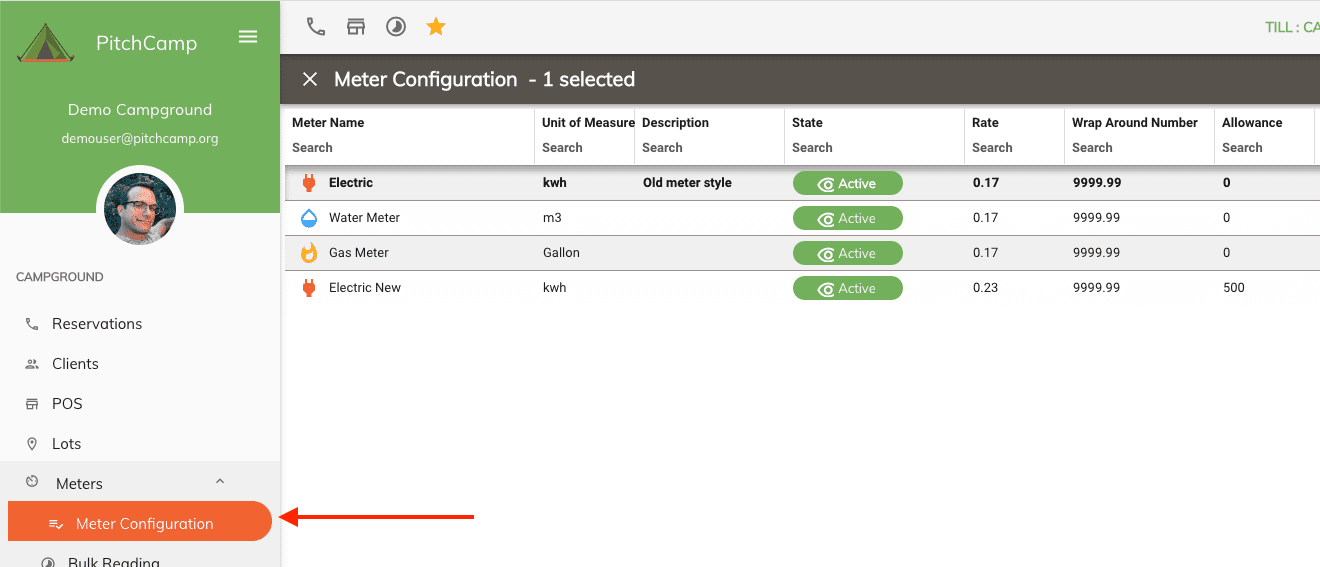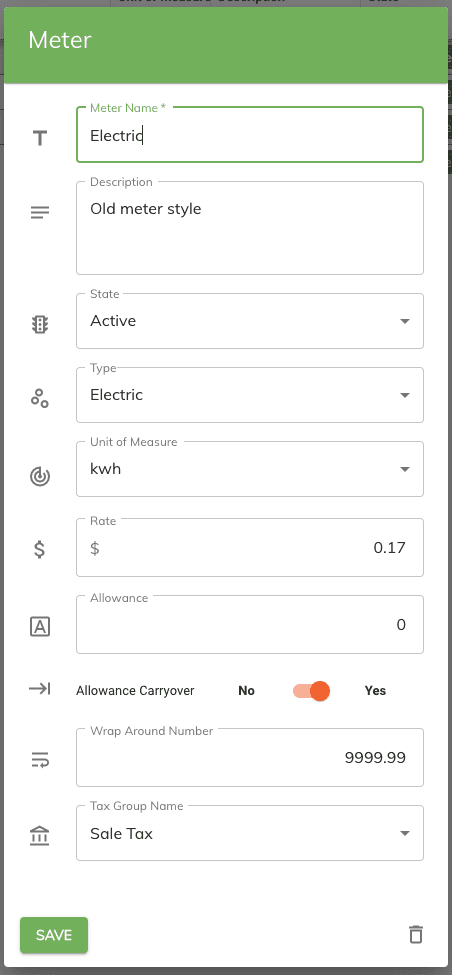Meter Configuration
Meter configurations allow you to defined what type of meters are used on your campground. Once a meter is configured it must be assigned to a lot before being able to enter a reading.
Note
A meter configuration is normally used to identify the type of meter we have on our campground. When linking up our meters to our lots we would typically reuse the same meter configuration for multiple lots.
Opening up the Meter Configuration¶
To open up the meter configuration go to Meters + Meter Configuration from the menu.

Adding a New Meter¶
To add a new meter click on the plus menu located in the top right of the panel.

Editing an Existing Meter¶
To edit an existing meter double click on the meter row.

Meter Panel¶
When adding or editing a meter the meter panel allows you to enter the details about the meter.

Meter Name¶
The meter name is what is used to identify a meter item. When entering a meter name it's good practice to enter the meter type then any additional information about the meter afterwards.
- Example of an electrical meter name for a 50 amp meter: Electric 50a
Description¶
The description area is to document any special notes on this meter. Note these notes are only visible to you.
State¶
The state allows to to make a meter active or not. This will prevent you from assigning this meter to a lot if it's not active.
Type¶
The lot type indicates what type of meter this is. There are three possible lot types.
- Electric
- Water
- Gas
Unit of Measure¶
The units of measure is what is used to identify what type of units this meter will keep track of. Note: the units of measure are filtered based on the meter type selected.
Example: when a meter type of Electric is selected you won't be able to select other units type except for kwh.
Meter Type to Unit of Measure Mapping¶
Here are the possible units of measure for each types.
| Meter Types | Unit of Measure |
|---|---|
| Electric | kwh |
| Water | m3 |
| Water | gallon |
| Water | liter |
| Water | ft3 |
| Gas | m3 |
| Gas | gallon |
| Gas | ft3 |
Rate¶
The rate is what is used to calculate the cost of the meter consumption. Example: if the meter cost is 17 cents per kwh then you would enter 0.17.
Allowance¶
The allowance field is used to give your clients a prepaid amount of paid units before they are charged.
Allowances balance can be carried over to the next meter reading and also to their next reservation given the same user account is used when booking the next reservations.
How Allowances Work¶
First Meter Reading¶
When a first meter reading is entered the allowance is taken from the designated meter configuration.
Example: If a lot/reservation is entering a meter reading for the first time and the meter configuration has an allowance of 300kwh then on the first reading the 300kwh will be in the allowance field of the meter reading.
Subsequent Meter Readings¶
On subsequent meter readings the remaining allowance of the previous reading will be used as the allowance value of the current reading and so on.
Client/Reservation Moved to Different Lot¶
During the lifetime of a reservation if a client is moved from lot A to lot B the remaining allowance for that client will follow them on to the next reading if the next meter reading is of the same type of meter.
Example: Let’s say that a client had a remaining allowance of 150kwh on an electrical meter for Lot #A. And they got moved or decided to change to Lot #B during the period of their reservation. Then on their next reading the remaining allowance from their previous reading for Lot #A will be applied given Lot #B also has a meter of the same type assigned to it.
New Reservation Meter Readings¶
Now let’s say that your seasonal client didn’t use up all their remaining allowance for the year. They would carry over the remaining allowance to their first meter reading on the new reservation given that the lot has a meter of the same type and the last meter reading was within 365 days.
Example: Let’s say they had 150kwh remaining from last year. And on the first meter reading the meter configuration had a 300kwh allowance. That would mean that the first reading would have a total of 450kwh allowance going forward.
- 300 from the meter configuration
- 150 from their previous year they didn't use up.
Allowance Carryover¶
The allowance carryover switch allows you to control should the remaining allowance be carried over to their next meter reading.
Example: Let's say that on the last meter reading we had a 150 kwh remaining but you don't wan't that amount to be carried over to the next reading. By turning off the allowance carryover would prevent the remaining 150kwh from being carried over to the next reading.
Wrap Around Number¶
A wrap around number on a meter reading typically refers to the number that appears on the counter when it reaches its maximum value and then resets back to zero.
The wrap around number is used to automatically calculate the wrap around logic so campground owners don't need to do it manually.
What number should I enter for the wrap around number¶
If your meter has four numbers plus two decimal points, the maximum value it can display is 9999.99. Therefore, the wrap around number for your meter would be 9999.99.
When the reading on your meter reaches 9999.99 and continues to increase, the display will roll over to 0000.00 and begin counting up from there.
Tax Group Name¶
Each meter can have a different tax associated to them or no tax. This allows you to control which tax a meter should use on the final calculation.